Notes to the Facilitator

This workshop provides participants with the opportunity to engage in mathematics as learners in order to make sense of that mathematics for teaching. This workshop is intended to support teachers and teacher leaders to situate this knowledge within learning progressions, classrooms, and the TQE (tasks, questioning, and evidence) process. The TQE process describes three key aspects of the teacher’s role: (1) selecting, adapting, or creating worthwhile tasks to address a specific learning goal; (2) using targeted and appropriate questioning strategies to support all learners; and (3) collecting evidence of students’ conceptual understanding and misconceptions related to the learning goal.
This workshop addresses three specific goals.
1. To explore meaningful tasks as learners of mathematics for teaching
2. To make sense of the TQE process
3. To create a shared vision of classrooms where teachers are supporting the TQE process and students are engaged in meaningful mathematics learning experiences
These goals are accomplished through the use of challenging tasks for teachers, questions related to using those tasks in classrooms, and classroom video where the tasks are modeled during instruction. Series authors introduce classroom video by highlighting important aspects of this workshop specifically and making sense of mathematics for teaching in general.
The workshop is divided into eight segments, and the corresponding video clip titles are listed in parentheses.
1. Welcome and Opening: This segment describes the series’ organization around a common structure—The Challenge, The Progression, The Mathematics, The Classroom, and The Response. Participants discuss the importance of making sense of mathematics for teaching in their own teaching and related roles.
2. Considering the Learner’s Role (Comparing Types of Functions Graphically): This segment allows participants to set their own goals for the workshop and connect to their role as learners in the teaching of mathematics. The observed lesson, in which students examine different sets of points and connect these sets to types of functions, demonstrates the importance of teachers creating environments in which students are active participants in their learning.
3. Using the TQE Process (Solving f (x) = g (x) Graphically): Participants explore a task that connects algebraic and graphical representations in ways that might challenge them. They discuss the processes they use to find solutions and anticipate how students might solve the same task. Participants then watch the video of a Making Sense of Mathematics for Teaching series’ author as she defines and shares the importance of the TQE process. The participants go on to watch the
1
classroom video using the same task they just explored. A follow-up discussion will connect what the participants observed in the video clip to the TQE process and the importance of planning for the TQE process.
4. Creating a Shared Vision of Classroom Instruction (Linking Graphical and Algebraic Solutions to Equations): This segment starts with participants viewing an author video discussing the importance of creating a shared vision of classroom discussion. Participants then anticipate how high school students might understand the connections between algebraic and graphical representations of the steps of solving an equation.
5. Making Sense of Mathematical Progressions (Exploring Different Ways That Lines Can Intersect): This segment helps participants make connections between different representations to solve equations and make sense of lines in high school. Participants discuss how the topics are related and fit into a learning progression that crosses grades.
6. Helping Students Make Sense of Mathematics (Interpreting Graphs to Create Context): In this segment, participants consider how tasks can challenge their teaching by exploring a task that involves making sense of a graph that represents a specific context. They begin by making sense of the task themselves and then think about—and observe—how students make sense of the same graph.
7. Considering the Teacher as Learner (Modeling a Bird’s Wings in Flight): This segment reminds participants of the importance of sense making for both students and teachers. It also reminds participants that teachers need to guide students to make sense of mathematics problems on their own. In creating multiple models for the graphical representation of a bird’s wings in flight, participants think about the importance of their content knowledge and flexible use of representations to ensure depth of student understanding.
8. Closing: In this segment, participants reflect on what they have learned in the workshop and plan for next steps.
Conducting the Workshop
This workshop is designed to last about eight hours. It can be scheduled for a single day consisting of two sessions or be scheduled over two days. All the professional development materials you need to conduct this workshop—the facilitator’s guide with detailed teaching suggestions and the video resources—are provided in this package.
To conduct a successful learning event, please consider the important issues that follow.
Preparation: Please view the entire video program, read all materials, and complete all activities yourself before leading the workshop.
Location: The workshop should take place in an area that is large enough for individual, team, and whole-group work.
Equipment: You will need a DVD player, a projector, and one or more monitors. You will also need a computer projector to show PowerPoint slides.
MAKING SENSE OF MATHEMATICS FOR TEACHING HIGH SCHOOL 2
Reproducible handouts and PowerPoint presentation: Reproducible handouts are included with this guide (starting on page 20 and on the CD). The handouts should be duplicated before the workshop begins and be distributed to participants according to the workshop instructions. A PowerPoint presentation is also included (on the CD).
Additional equipment: You will also need flip charts, chalkboards, or whiteboards with appropriate writing materials (blank paper and markers, pens, or pencils) to conduct the workshop.
Refreshments: The workshop’s agenda should include one or more breaks at which beverages are offered. Snacks and lunch are optional, but water should be available throughout the workshop.
Video Program
This workshop incorporates a video program that is approximately forty-four minutes in length. The video will be used throughout the workshop. It is used to introduce some segments and to close others. Most often, the video provides both a suggestion for what to look for during planning and instruction as explained by series authors as well as an example of what model instruction looks like in the classroom through authentic classroom video. It might be helpful to replay certain video portions for participants and also to pause so participants can reflect on what they have seen.
Other Resources
Print
Making Sense of Mathematics for Teaching Grades K–2
Making Sense of Mathematics for Teaching Grades 3–5
Making Sense of Mathematics for Teaching Grades 6–8
Video
Making Sense of Mathematics for Teaching Grades K–2: The TQE Process
Making Sense of Mathematics for Teaching Grades 3–5: The TQE Process
Making Sense of Mathematics for Teaching Grades 6–8: The TQE Process
Notes to the Facilitator 3
Workshop Steps and Teaching Suggestions: Statement of Purpose

It is important for participants to engage in productive struggle around high-cognitive-demand tasks as learners, and then to plan for how those same tasks might be supported during instruction through the use of appropriate questioning as teachers. Use the videos to explore how evidence can be collected as part of the formative assessment process during instruction.
Learning Objectives
After viewing the video and participating in the workshop activities, participants will be able to:
Identify high-cognitive-demand tasks
Adapt existing low-cognitive-demand tasks to make them high cognitive demand
Plan questions to support students to engage in productive struggle around high-cognitivedemand tasks
Collect evidence of student conceptions and misconceptions through productive questioning while students work to solve tasks
Program Overview
The video associated with this workshop offers perspectives from Edward C. Nolan, Juli K. Dixon, Farshid Safi, Erhan Selcuk Haciomeroglu, and Thomasenia Lott Adams—all authors of the Making Sense of Mathematics for Teaching series—related to mathematics content knowledge for teaching, the TQE process, and progressions for learning mathematics. Edward, Juli, and Farshid model best practices through authentic classroom video to create a shared image of students engaged in meaningful experiences related to mathematics learning.
Materials
Video program: Making Sense of Mathematics for Teaching High School: The TQE Process
PowerPoint presentation slides
Reproducible handouts:
“Task 1: Considering the Learner’s Role”
“Task 2: Using the TQE Process”
“TQE Analysis Tool”
7
“Task 3: Creating a Shared Vision of Classroom Instruction”
“Task 4: Making Sense of Mathematical Progressions”
“Classroom Video Analysis Tool”
“Task 5: Helping Students Make Sense of Mathematics”
“Task 6: Considering the Teacher as Learner”
Flip charts, chalkboards, or whiteboards and appropriate writing materials
Activities
It is best to follow the activities as outlined in the workshop teaching suggestions and pause the video when prompted. After showing each video segment, allow participants time to comment or ask questions about the material. If requested, you can replay video portions as participants consider the questions and activities.
Welcome and Opening
1. Welcome participants to the workshop, and introduce yourself and anyone else serving as a workshop host, cofacilitator, or organizer.
2. If participants do not know one another well, conduct an icebreaker. Ask participants to form pairs and interview each other for about five minutes. Then ask the pairs to introduce each other to another pair, stating the person’s name, something interesting or different about the person, and what the person hopes to gain from the workshop.
3. Begin the workshop showing PowerPoint slide 1; then begin the DVD as Juli discusses the need for making sense of mathematics for teaching. Juli describes how the text is organized as well as how teachers experience mathematics tasks within the text as learners and then as facilitators of mathematics learning. Pause the video at the “Pause for group work” screen. Have the participants provide their perspectives on their role in this process. Use the following questions as a guide.
i. When was the last time you experienced mathematics as a learner?
ii. Where are you in understanding the progression of the high school standards?
iii. What should those standards look like in a classroom? Who decides?
iv. How do you respond to students when students do or do not understand?
v. What questions do you ask to assess students’ understanding in relation to a specific standard?
4. Show slide 2 to provide a general overview of the session goals. Within this session, participants will explore various mathematics tasks as learners, make sense of those tasks through the TQE process, and create a shared image of classrooms where teachers use the TQE process to ensure students are engaged in meaningful mathematics learning experiences.
MAKING SENSE OF MATHEMATICS FOR TEACHING HIGH SCHOOL 8
Considering the Learner’s Role
This segment is designed to help participants consider their goals for the workshop and think about the impact of incorporating rich and engaging tasks in instruction.
1. Show slide 3.
2. Show slide 4 and distribute the handout “Task 1: Considering the Learner’s Role.” Have participants complete the task and share their thinking about the type of function each set of points represents. Ask them how they would involve students in completing this task.
3. Show slide 5. Discuss the questions on the slide related to the learner’s role in mathematics instruction.
4. Click on “Next Segment” to watch Edward discuss different considerations for professional development. Pause the video at 40 seconds.
5. Ask participants to identify what they hope to learn from the workshop.
6. Show slide 6. Discuss different ways that participants successfully engage students. Ask participants, “How would you encourage students to make sense of this task? How do you encourage student engagement in your lessons? What works and what has not worked?”
7. Resume the video. You can play the video clip “Comparing Types of Functions Graphically” all the way through to the “Pause for group work” screen or pause it throughout for discussion. Suggested pauses:
i. Pause at 1:16—The teacher asks the students who have been working in small groups to describe what they noticed.
ii. Pause at 1:29—After one student notices the pattern of points that represents a linear function, the teacher turns to a different student and asks him to make sense of what the first student said. Ask participants, “Why do you think the teacher made this move at this point? What are its implications?”
iii. Pause at 1:42—The second student mentions a vertical line with a positive slope. The teacher responds by asking, “Is it a vertical line or one with a positive slope?” The teacher does this to attend to precision and to the significance of using the correct mathematics terminology. Note that this question leads the student to correct his own thinking.
iv. Pause at 2:46—As part of the learning goal, the teacher wishes to connect the relationship between points provided in the task to the type of function that could represent such behavior. He states, “Think about the relationship between the points that he is writing to see if that helps us,” to scaffold the small group’s discussion just in time.
v. Pause at 4:46—After a student identifies an exponential function, the teacher emphasizes the importance of explanation and justification. He pushes for an explanation by asking, “How do you know?” The student describes the relationship and rate of growth of the points. The teacher maintains focus on the task’s learning goal and attempts to engage the whole class in the strategy being described.
8. Pause the video at the “Pause for group work” screen. Show slide 7. Ask participants if the classroom video was what they anticipated. Discuss the importance of using classroom video
Workshop Steps and Teaching Suggestions: Statement of Purpose 9
to develop a shared understanding and vision of the mathematics and how to support that shared understanding and vision in the classroom. After this discussion and after entertaining participants’ questions, ask participants how the teacher engaged the students in the lesson. Discuss the questioning the teacher used and the feedback he provided.
Using the TQE Process
This segment is designed to help participants see the value of using the TQE process by being intentional about selecting tasks, asking students targeted questions, and collecting evidence of students’ conceptions and misconceptions.
1. Show slide 8.
2. Show slide 9. Distribute the handout “Task 2: Using the TQE Process.” Ask participants to complete the task, thinking of the task as comparing f (x) = x2 – 4x and g (x) = 5.
3. Ask the participants to sketch graphs of the two functions, and discuss the functions’ relationship and what impact that has on the solution.
4. Show slide 10. Ask the participants to consider how to introduce this task to students and how students would solve the problem. The goal at this point is to support participants to make sense of the TQE process. After completing the task, they will explore what questions they might use with students. Eventually, they will watch the video to see what evidence was collected for this task.
5. Ask the participants to consider how they can support multiple strategies that students would use in the task and how they can extend the task to learn more about what students understand.
6. Show slide 11. Then click on “Next Segment” to watch Thomasenia Lott Adams discuss the TQE process. Pause the video at 2:05.
7. Show slide 12 and distribute the handout “TQE Analysis Tool.” Discuss the overview of the TQE process and introduce the “TQE Analysis Tool” to help participants connect classroom instruction to the TQE process.
8. Show slide 13. Play the video clip “Solving f (x) = g (x) Graphically,” which shows high school students exploring the f (x) = g (x) task with x2 – 4x = 5 that the participants just completed. Allow participants to use the “TQE Analysis Tool” to capture what they see in the video. Suggested pauses:
i. Pause at 2:47—The teacher instructs the students to sketch the functions on their whiteboards and in their groups think about how they can use this information to make sense of the problem. In emphasizing that the students explore the equation as two separate functions graphically, the teacher quite explicitly provides detailed instructions at the outset to frame what the students do. Note that some students base their approaches on misconceptions. The teacher circulates in order to observe these different strategies as students work on the task.
ii. Pause at 3:36— Students are expected to be responsible for their sense making during the classroom discussion. The teacher purposefully asks a student to describe her approach by stating, “Tell us what you have done.”
10
MAKING SENSE OF MATHEMATICS FOR TEACHING HIGH SCHOOL
iii. Pause at 4:03—Note the teacher points specifically to the points of intersection on the graph. The main goal of the task is to solve the given functions graphically and identify the role of the points of intersection on the graph, so the teacher draws attention to the strategy employed by the student.
iv. Pause at 4:33—An important aspect of the learning goal involves determining the number of possible solutions in this task. The teacher asks the question, “Does there have to be two solutions?” This is included as part of the sequence of solving equations using this approach.
v. Pause at 4:58—Following a student response, the teacher asks a different student whether she agrees with the previous assertion and pushes for her explanation and justification by asking, “Why?” Through this teaching move, the teacher highlights that students should be able to critique others’ reasoning and make sense of the mathematics.
vi. Pause at 5:42—The teacher facilitates extending student thinking by asking a deeper level question: “What would have to happen for there to be no solution?” Following the student response, he pushes for precision by asking, “Could it be any negative number?” Through this important dialogue, the teacher draws the whole class’s attention to this possibility, consistent with the learning goal of the task. Once again, the teacher facilitates sense making done by the student.
vii. Pause at 6:10—Due to the complexity of this task, the teacher summarizes the various cases discussed and again draws attention to the original learning goal of solving f (x) = g (x) graphically.
9. Pause the video at the “Pause for group work” screen. Show slide 14. Ask participants if the classroom video was what they anticipated. Discuss the importance of using classroom video to develop a shared understanding and vision of the mathematics and how to support that shared understanding and vision in the classroom. After this discussion and after entertaining participants’ questions, ask participants how the teacher supported students to engage in a challenging task. Participants should indicate that the teacher did not give away the answers but rather assessed for understanding and then asked probing questions to guide students to this important relationship between representations of functions that students often find challenging to grasp.
10. Show slide 15. Discuss the importance of using classroom video to develop a shared understanding and vision of the mathematics and how to support that shared understanding and vision in the classroom. Use the overview of the TQE process to guide discussion.
Creating a Shared Vision of Classroom Instruction
This segment is designed to help participants see the value of using classroom video to create a shared vision of classroom instruction.
1. Show slide 16.
2. Click on “Next Segment” to watch Juli discuss how the use of video provides shared images of best practices in the classroom. Pause the video at 40 seconds.
Workshop Steps and Teaching Suggestions: Statement of Purpose 11
3. Distribute the handout “Task 3: Creating a Shared Vision of Classroom Instruction,” and have participants complete the task.
4. Show slide 17. Ask participants to connect the representations. Discuss how they approached the task as learners. Ask participants:
i. “What does the graph represent?”
ii. “What does the point of intersection represent?”
iii. “What would the next step in the solution look like as a graph?”
iv. “What is the same in each representation, and what is different?”
5. Show slide 18 and distribute the “TQE Analysis Tool.” Ask participants, “What do you anticipate students will do with this task? How might students solve it? What would instruction look like?” Facilitate a discussion so that participants can compare their visions for classroom discussion to see if they are the same. They are likely not the same.
6. Play the video clip “Linking Graphical and Algebraic Solutions to Equations.” Students explore the 4x + 2 = 2x + 4 task that the participants just completed. Allow participants to use the “TQE Analysis Tool” to capture what they see in the video. Suggested pauses:
i. Pause at 2:04—Following one student’s explanation of the relationship between the x-values, the teacher asks a different student in the group, “What does she mean if you plug in x into the equation, you get 6?” As the student begins to describe his strategy, the teacher refocuses his attention on the original strategy and holds him accountable for making sense of the other student’s strategy.
ii. Pause at 2:22— Once the teacher has facilitated the discussion within this small group, the teacher asks the student who has explained it again to stop and returns to the student who was not sure of the original strategy. This supports encouraging students to persevere and continue to work to make sense of challenging tasks. When he says that he does not know, the teacher responds, “So you have a question to ask.” In this manner, the teacher demonstrates facilitating small-group discussions while engaging all students. In this one short episode, each member of the small group is engaged and expected to make sense of the mathematics with the teacher’s guidance and facilitation.
iii. Pause at 7:41—Following the rich classroom discussion she prompted by asking purposeful questions, the teacher summarizes the learning goal of this task. It is critical that students realize the connections between symbolic and graphical approaches and how they may use both to solve equations.
7. Pause the video at the “Pause for group work” screen.
8. Show slide 19. Ask participants if the classroom video was what they anticipated. Discuss the importance of using classroom video to develop a shared understanding and vision of the mathematics and how to support that shared understanding and vision in the classroom. After this discussion and after entertaining participants’ questions, ask about the TQE process and what questions the teacher used and what evidence she was able to collect.
9. Ask the participants what they think the teacher should do next.
OF MATHEMATICS
TEACHING
12
MAKING SENSE
FOR
HIGH SCHOOL
10. Discuss how viewing the video together helps in having a productive discussion regarding next steps. Ask participants, “How did watching the same video help create a shared vision around the task?”
11. Show slide 20. Connect what participants observed with the questions they considered and the anticipated evidence for Mathematical Practices. Remind participants that the practices are about what the students are doing, not the teacher.
Making Sense of Mathematical Progressions
This segment is designed to help participants explore teaching with coherence and learning progressions.
1. Show slide 21.
2. Show slide 22 and distribute the handout “Task 4: Making Sense of Mathematical Progressions.” Ask the participants to complete the task and discuss different points of view. Then ask participants:
i. “How did you make your predictions? What characteristics of these equations helped you make your predictions?”
ii. “How did your knowledge impact your thinking?”
iii. “How might your thinking about this task impact your instruction for students?”
3. Show slide 23. Then click on “Next Segment” in the video to watch Edward discuss learning progressions. Pause the video at 24 seconds. Have participants discuss the question on the slide, and ask participants, “Why is it important for teachers to know what comes before and after their grade levels’ or courses’ content?”
4. Show slide 24. Have participants discuss the questions on the slide and the following questions regarding the task shown on slide 22.
i. What types of successes and challenges will students have on this task?
ii. What questions will you ask students during this task?
iii. What responses do you anticipate, and what will you do based on each response?
5. Distribute the handout “Classroom Video Analysis Tool.” Resume the video to view the clip “Exploring Different Ways That Lines Can Intersect,” showing high school students exploring the systems of equations task that the participants just completed. Ask participants to use the “Classroom Video Analysis Tool” to capture what they see in the video clip. Suggested pauses:
i. Pause at 2:07—The teacher focuses on reasoning and sense making by asking students in a small group, “How do we know two lines are parallel?” After one student responds, the teacher checks for agreement among the other group members and then asks, “Why do we think equation 1 and equation 3 do not intersect?” Note that the students are given the equations of the lines, so they have to reason without seeing the graphs. When the students struggle to answer the why question, the teacher asks them to continue thinking about the task and to write down their predictions. Here, this teacher’s move encourages the students to persevere in thinking through this task, and he holds the group members accountable.
Workshop Steps and Teaching Suggestions: Statement of Purpose 13
ii. Pause at 3:56—Following a series of short questions about what the students noticed about a pair of parallel lines, the teacher sequences his questions to ask them about two equations that represent the same line by asking, “What do you know about the rate of change of equations 1 and 4?” He then proceeds by posing the question, “How do you know two lines are parallel versus when they are the same line?” In this manner, the teacher facilitates a discussion in the small group about lines that have the same rate of change and are the same line versus lines that have the same rate of change but represent different lines.
iii. Pause at 6:00—When the teacher brings the whole class back together, he begins to summarize the evidence he has gathered from his interactions with the students in small groups. He poses questions about the relationship between lines that intersect, and a student responds that they have different slopes. Next, the teacher orchestrates a whole-class discussion about lines that have the same slope and asks, “Is there any other possibility?” besides their being parallel. After eliciting the student response that those lines can be the same line, the teacher adds that when two lines are the same, they have “an infinite number of points of intersection.” Through his interactions with students in the small-group and whole-class discussions, the teacher elicits and summarizes all three possible cases for the intersection of two lines. In this manner, students have had the opportunity to explore different ways that lines can intersect and connect their graphical understanding with the lines’ rate of change.
6. Pause the video at the “Pause for group work” screen.
7. Show slide 25. Ask participants if the classroom video was what they anticipated. After this discussion and after entertaining participants’ questions, ask participants how the teacher incorporated the TQE process in instruction. Show slide 26 as a reminder of the TQE process.
8. Discuss how completing the task and considering questions prior to the video impacted what the participants observed and how they were impacted by it.
9. Show slide 27. Ask participants, “How was this video similar to or different from the previous video focused on the number of points of intersection between lines? What other topics cross grade bands in similar ways?”
Helping Students Make Sense of Mathematics
This segment is designed to help participants think about how to support students to make sense of mathematics.
1. Show slide 28.
2. Show slide 29 and distribute the handout “Task 5: Helping Students Make Sense of Mathematics.” Allow time for participants to write and share stories. Listen carefully for accurate descriptions of what happens at points A, B, and C, as well as the correct use of terms such as speed, rate, and distance. Have participants consider how this is a rich task.
i. Discuss the merits of the task and how it engages students.
ii. Discuss possible misconceptions students may demonstrate and what to do about them through questioning and the collection of evidence.
MAKING SENSE OF MATHEMATICS FOR TEACHING HIGH SCHOOL 14
3. Show slide 30. Have participants discuss the questions on the slide. Also, ask them, “What do you think are the key aspects of this task, which you need to be ready to address when teaching it?”
4. Click on “Next Segment” to watch Farshid discuss teachers making sense of mathematics in order to support students’ sense making. Pause the video at 31 seconds.
5. Distribute the handout “TQE Analysis Tool.” Resume the video to view the clip “Interpreting Graphs to Create Context,” which shows high school students exploring the systems of equations task that participants just completed. Have the participants complete the “TQE Analysis Tool” to capture what they see in the video. Suggested pauses:
i. Pause at 1:51—As the students begin to create their own context in the task, the teacher inquires about the story one group has created. Even though the students verbalize a mathematics misconception about the son starting to go faster, the teacher purposefully does not correct them, as the whole class is still working to make sense of this task. This is a key step because teachers at times “rescue” students too quickly instead of providing opportunities for students to reexamine their thinking on their own and participate in classroom discussions.
ii. Pause at 3:45— Students in another group begin to make sense of the father’s and the son’s acceleration. One student realizes the connection, and the teacher intentionally stops her and says, “I know what you mean. I want to see what someone else knows.” If the teacher does not interrupt her, that student would do all the sense making, and the other students would not engage in understanding the mathematics. Sense making is an expectation for all students, and the teacher orchestrates the small-group discussion to ensure that all students take part in the learning process.
iii. Pause at 7:06— Once the teacher has gathered evidence of a repeated misconception, the teacher mentions, “That’s an interesting point. We are going to talk about that as a whole class.” Then she engages the entire class in discussion. The TQE process is on display, as the task has enabled the students to explore the mathematics, and the teacher has facilitated their thinking through purposeful questioning strategies and gathered evidence to support student thinking.
6. Pause the video at the “Pause for group work” screen.
7. Show slide 31. Ask participants if the classroom video was what they anticipated. Discuss the importance of using classroom video to develop a shared understanding and vision of the mathematics and how to support that shared understanding and vision in the classroom. After this discussion and after entertaining participants’ questions, ask participants how the teacher engaged the students in the task.
8. Show slide 32. Have participants discuss the questions on the slide. Participants should see that the teacher used questions to access the thinking of different levels of students. They should also notice that the teacher did not provide feedback to students about whether their answers were correct but waited until the whole-class discussion to determine the correct solution.
9. Ask participants how the teacher incorporated the TQE process in instruction. Also, ask, “What misconceptions did the students demonstrate, and how did the teacher address them?” The
Workshop Steps and Teaching Suggestions: Statement of Purpose 15
teacher collected evidence that some students began with misconceptions but then came to a good understanding. Some students represented a common error, but the whole-class discussion allowed the students to learn from one another.
Considering the Teacher as Learner
This segment is designed to help participants explore mathematics as learners.
1. Show slide 33 and distribute the handout “Task 6: Considering the Teacher as Learner.”
2. Show slide 34. Ask participants to complete the task and look for different functions that will model the representation. Look at different functions they create, and make connections between some of them (such as using both square root and opposite square root functions—both with limited domains—that could represent one pair of “wings” on each side of the y-axis. Another example could be the absolute value function combined with the square root function—also with a limited domain—that would be another way to represent a pair of wings). This provides a great opportunity to discuss the role of technology in the mathematics classroom, and participants can share multiple models using different forms of technology, such as graphing calculators and online graphing programs.
3. Show slide 35. Have a conversation about the questions on the slide: “Why is it important to complete a task prior to teaching it to students? How can thinking about the mathematics impact your teaching practice?”
4. Click on “Next Segment” to watch Edward discuss the teacher as learner. Pause the video at 33 seconds.
5. Show slide 36 and distribute the “TQE Analysis Tool.” Resume the video to view high school students exploring the task “Modeling a Bird’s Wings in Flight,” and have participants complete the “TQE Analysis Tool.” Suggested pauses:
i. Pause at 1:57—The teacher circulates among small groups to gather evidence of student thinking. Note that some students think about using absolute value functions as a way to model a bird’s wings in flight. Keep this in mind as the classroom discussion continues.
ii. Pause at 2:35—A student refers to the number that “comes before x.” The teacher seizes the opportunity to attend to precision by asking a clarifying question of the student: “What do we call the number that comes before x?” This student responds, “The coefficient.” In this example, the teacher facilitates using proper mathematics terminology, and the other students in the group learn from this conversation, as can be seen later on in this video.
iii. Pause at 3:13—The teacher facilitates a whole-class discussion by mentioning two different strategies illustrated in the class. It is noteworthy that he calls on a different student to describe what it means to use a square root function, as the teacher already knows what two groups discussed. All students are expected to take part in classroom discussions.
iv. Pause at 4:41—Using absolute value functions represents a key aspect of using different representations to show the same curves, and is consistent with the learning goal of this modeling task. Knowing the strategy’s importance, the teacher purposefully calls on the student who has begun to make sense of the absolute value function so the whole class
MAKING SENSE OF MATHEMATICS FOR TEACHING HIGH SCHOOL 16
REPRODUCIBLE HANDOUTS
REPRODUCIBLE
Task 1: Considering the Learner’s Role
Examine the series of points provided and determine what type of function or functions could be represented in each case.
Explain your reasoning.
Making Sense of Mathematics for Teaching High School: The TQE Process © 2017 Solution Tree Press • SolutionTree.com Visit go.SolutionTree.com/mathematics to download this free reproducible.
20
10 9 8 7 6 5 4 3 2 1 0 –1 –4 –3 –2 –1 0 1 2 3 4
Task 2: Using the TQE Process
Consider this equation:
x2 – 4x = 5
How can thinking of this as f ( x ) = g ( x ) and sketching each function help to determine the number of solutions to this equation?
Making Sense of Mathematics for Teaching High School: The TQE Process © 2017 Solution Tree Press • SolutionTree.com Visit go.SolutionTree.com/mathematics to download this free reproducible.
REPRODUCIBLE 21
Making Sense of Mathematics for Teaching High School: The TQE Process © 2017 Solution Tree Press • SolutionTree.com Visit go.SolutionTree.com/mathematics to download this free reproducible.
22
Describe the Task Describe the Questioning Describe the Evidence Collected
REPRODUCIBLE
TQE Analysis Tool
Task 3: Creating a Shared Vision of Classroom Instruction
Solve the problem. Two students were asked to solve for x given 4x + 2 = 2 x + 4. One solved it graphically, and the other solved it symbolically.
How are the solutions related?
Making Sense of Mathematics for Teaching High School: The TQE Process © 2017 Solution Tree Press • SolutionTree.com Visit go.SolutionTree.com/mathematics to download this free reproducible.
REPRODUCIBLE 23
4x + 2 = 2 x + 4 4x = 2 x + 2 2 x = 2 x = 1 8 7 6 5 4 3 2 1 0 –1 -2 -3 –4 –2 0 2 4
Task 4: Making Sense of Mathematical Progressions
Predict which two equations will be parallel when graphed and which two equations will intersect when graphed.
Equation 1 x + 3y = 3
Equation 2 y = –1/ 3 x – 2
Equation 3 y = 3x + 1
Equation 4 2 x = –6y + 6
Making Sense of Mathematics for Teaching High School: The TQE Process © 2017 Solution Tree Press • SolutionTree.com Visit go.SolutionTree.com/mathematics to download this free reproducible. REPRODUCIBLE 24
REPRODUCIBLE 25
Classroom Video Analysis Tool
Describe the student discourse.
Describe the teacher actions that support student engagement.
Which Mathematical Practices are emphasized?
What expectations (spoken or understood) are communicated to the students?
Making Sense of Mathematics for Teaching High School: The TQE Process © 2017 Solution Tree Press • SolutionTree.com Visit go.SolutionTree.com/mathematics to download this free reproducible.
Task 5: Helping Students Make Sense of Mathematics
This task involves a father (F) and son’s (S) 100-meter race. Write a story that matches the graph. Be sure to include what is occurring at A, B, and C as well as the intervals in between.
Making Sense of Mathematics for Teaching High School: The TQE Process © 2017 Solution Tree Press • SolutionTree.com Visit go.SolutionTree.com/mathematics to download this free reproducible. REPRODUCIBLE 26
100 80 60 40 20 0 0 2 4 6 8 10 A B C S Distance (meters) Time (seconds) F
Task 6: Considering the Teacher as Learner
Examine the graph below and determine what type of function or functions could be used to mathematically model the flight of the bird. Explain your reasoning.
Making Sense of Mathematics for Teaching High School: The TQE Process © 2017 Solution Tree Press • SolutionTree.com Visit go.SolutionTree.com/mathematics to download this free reproducible.
REPRODUCIBLE 27
-15 -10 -5 5 10 15 15 10 5 0 –5
28 MAKING SENSE OF MATHEMATICS FOR TEACHING HIGH SCHOOL
29 Notes
30 MAKING SENSE OF MATHEMATICS FOR TEACHING HIGH SCHOOL
31 Notes
32 MAKING SENSE OF MATHEMATICS FOR TEACHING HIGH SCHOOL
33 Notes
34 MAKING SENSE OF MATHEMATICS FOR TEACHING HIGH SCHOOL
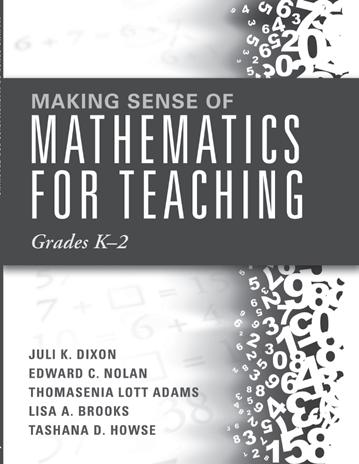
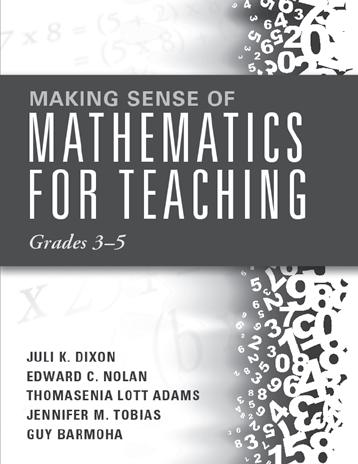
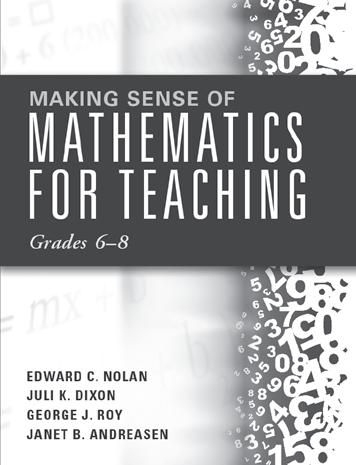
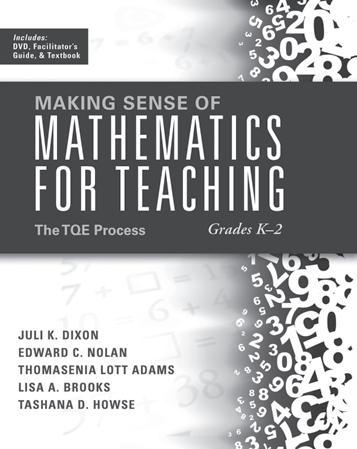


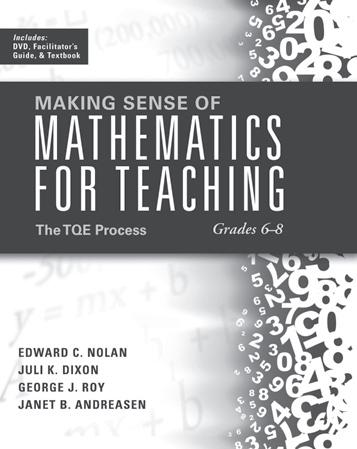

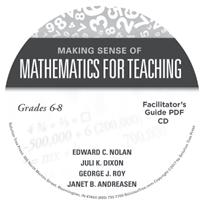
Making Sense of Mathematics for Teaching Grades K–2
Juli K. Dixon, Edward C. Nolan, Thomasenia Lott Adams, Lisa A. Brooks, and Tashana D. Howse
Develop a deep understanding of mathematics. With this user-friendly resource, grades K–2 teachers will explore strategies and techniques to effectively learn and teach significant mathematics concepts and provide all students with the precise, accurate information they need to achieve academic success.
BKF695
Making Sense of Mathematics for Teaching Grades 3–5
Juli K. Dixon, Edward C. Nolan, Thomasenia Lott Adams, Jennifer M. Tobias, and Guy Barmoha
Develop a deep understanding of mathematics. With this user-friendly resource, grades 3–5 teachers will explore strategies and techniques to effectively learn and teach significant mathematics concepts and provide all students with the precise, accurate information they need to achieve academic success.
BKF696
Making Sense of Mathematics for Teaching Grades 6–8
Edward C. Nolan, Juli K. Dixon, George J. Roy, and Janet B. Andreasen
Develop a deep understanding of mathematics. With this user-friendly resource, grades 6–8 teachers will explore strategies and techniques to effectively learn and teach significant mathematics concepts and provide all students with the precise, accurate information they need to achieve academic success.
BKF697
Making Sense of Mathematics for Teaching Grades K–2: The TQE Process
Juli K. Dixon, Edward C. Nolan, Thomasenia Lott Adams, Lisa A. Brooks, and Tashana D. Howse
This video program will help educators develop a deeper understanding of mathematics and more effectively provide mathematics instruction in grades K–2. Included is the companion paperback book, Making Sense of Mathematics for Teaching Grades K–2.
DVF067
Making Sense of Mathematics for Teaching Grades 6–8: The TQE Process
Edward C. Nolan, Juli K. Dixon, George J. Roy, and Janet B. Andreasen
This multimedia workshop helps create a shared vision of classrooms where teachers and students are engaged in meaningful mathematics learning experiences.
DVF069
Video Content Visit SolutionTree.com or call 800.733.6786 to order.
Bonus Online Video Content Video Content























